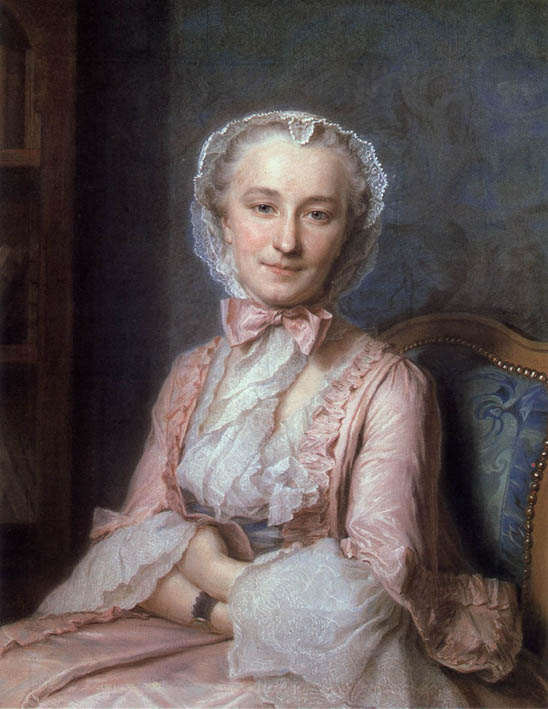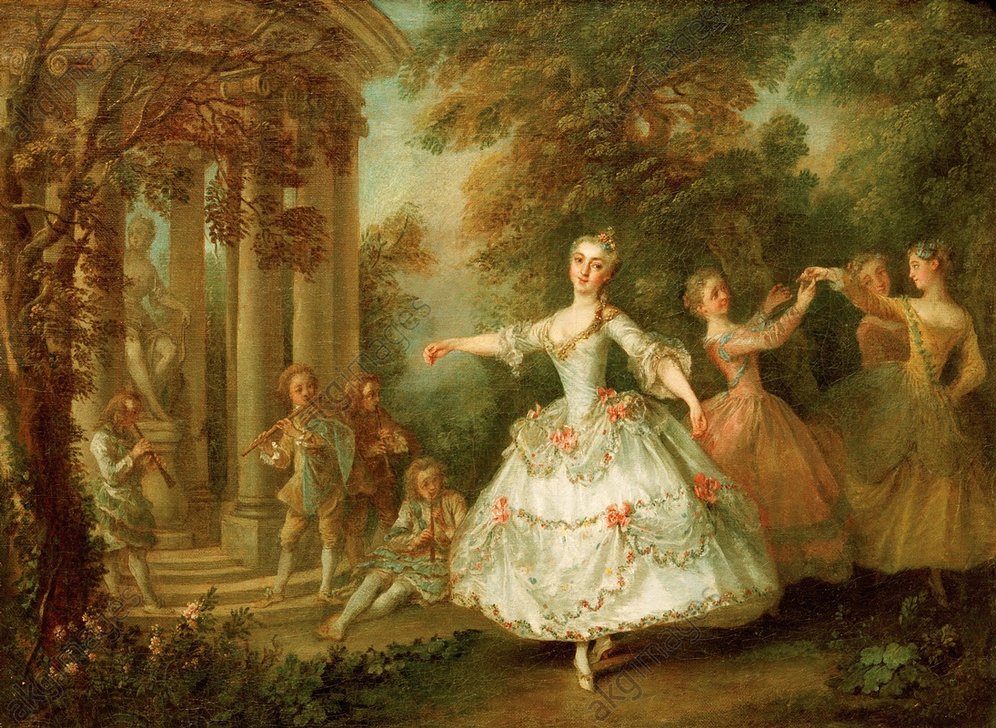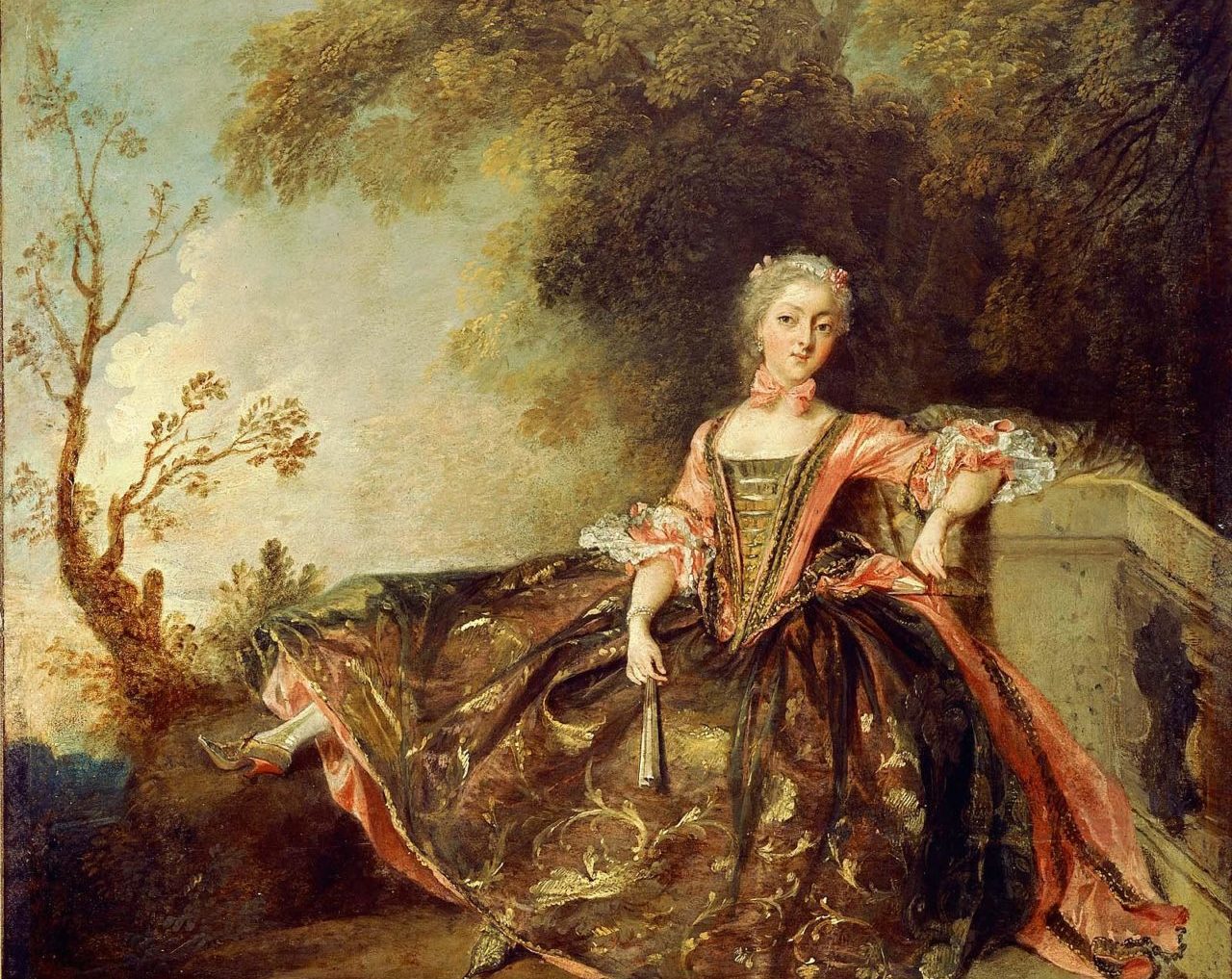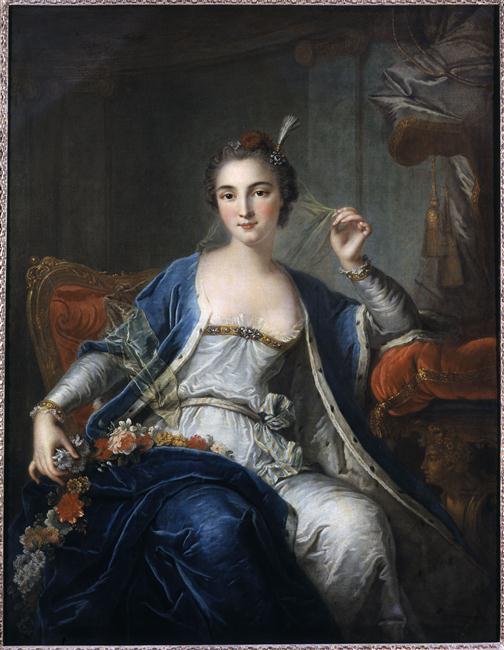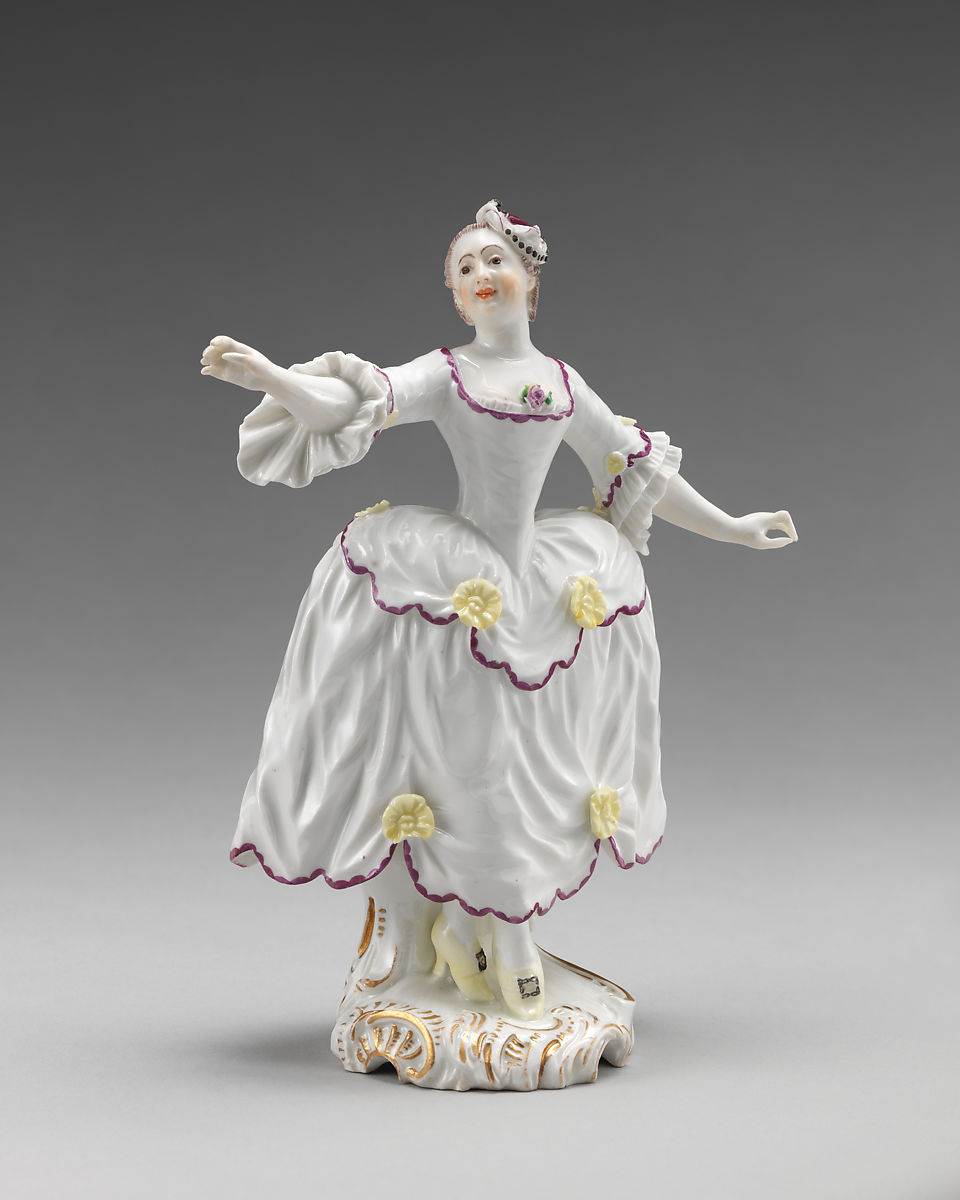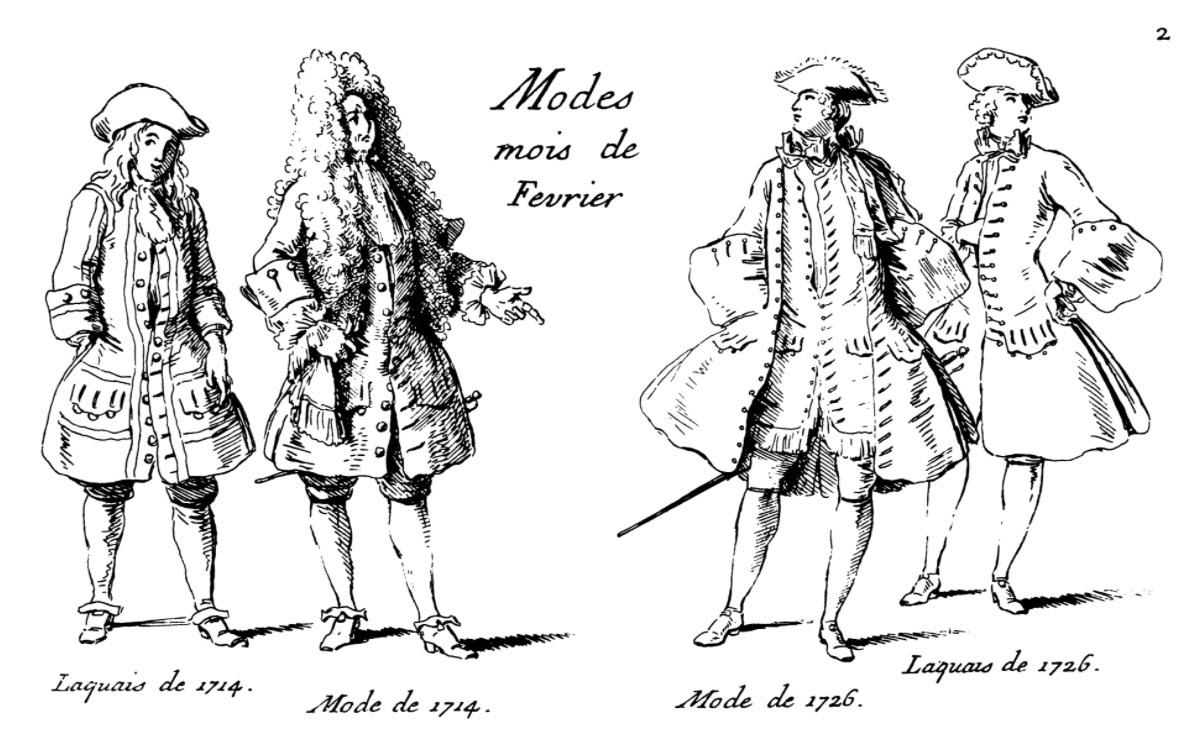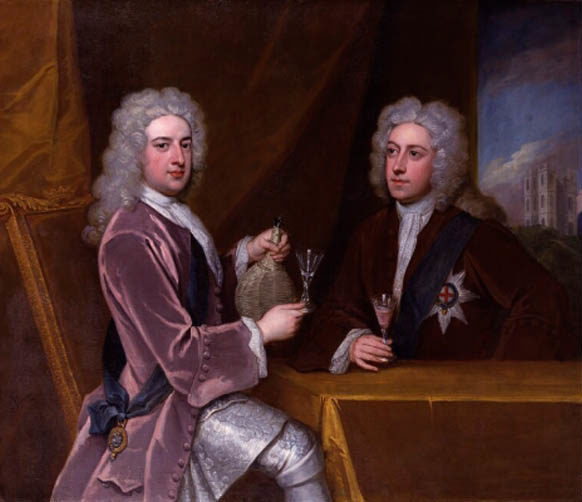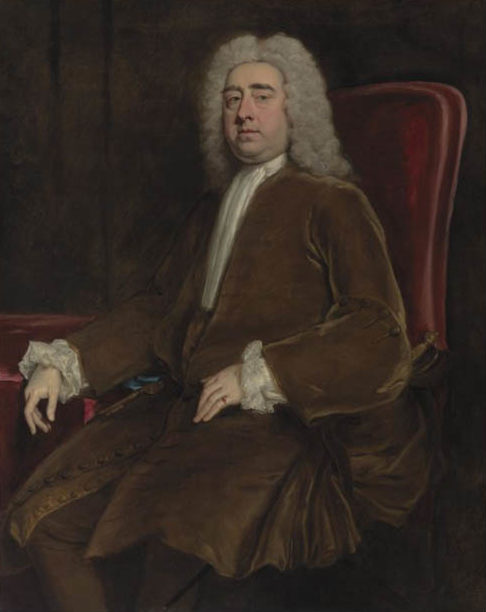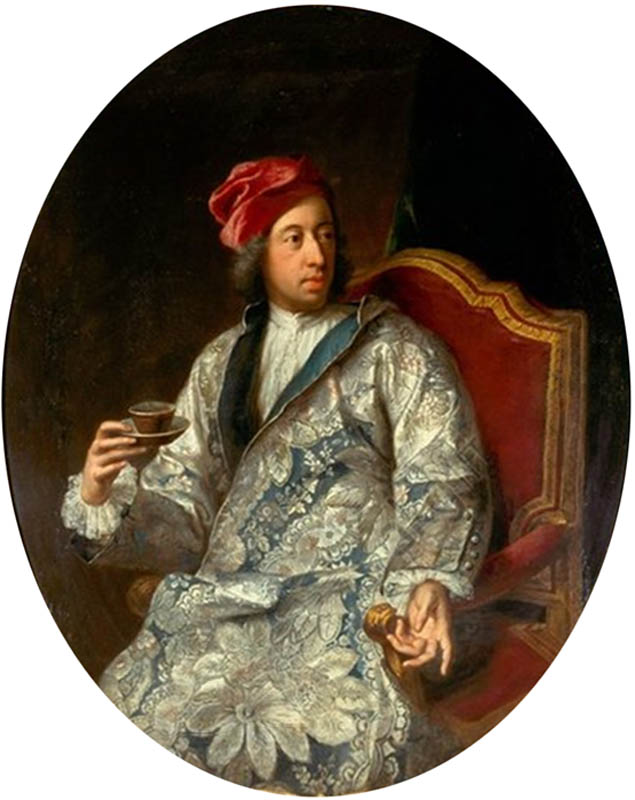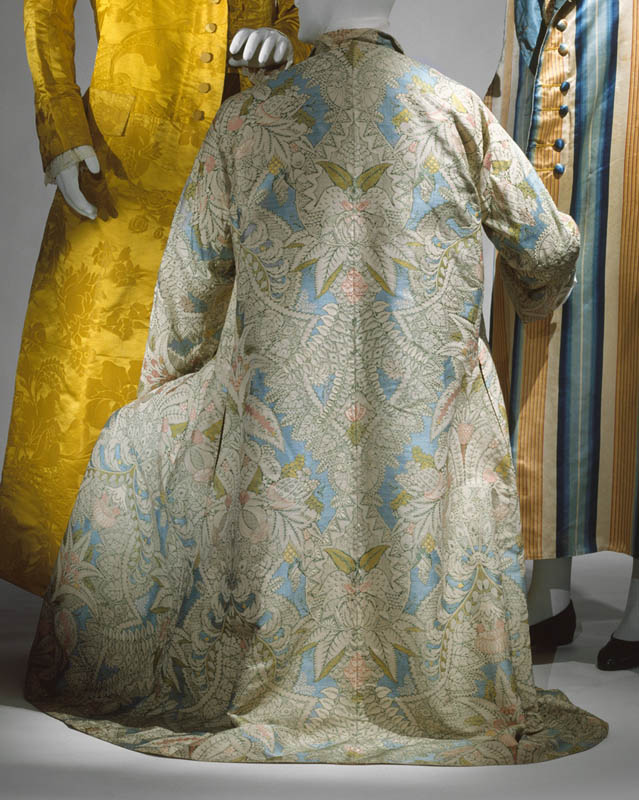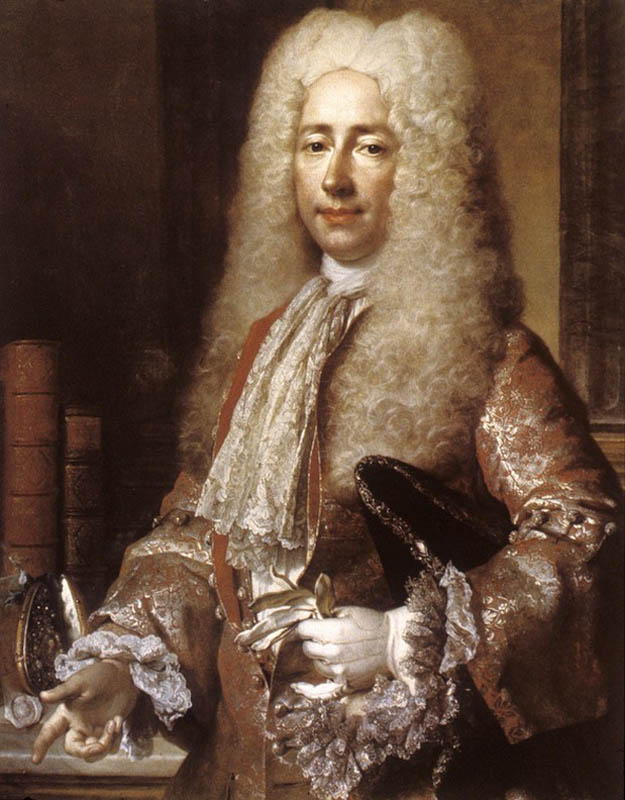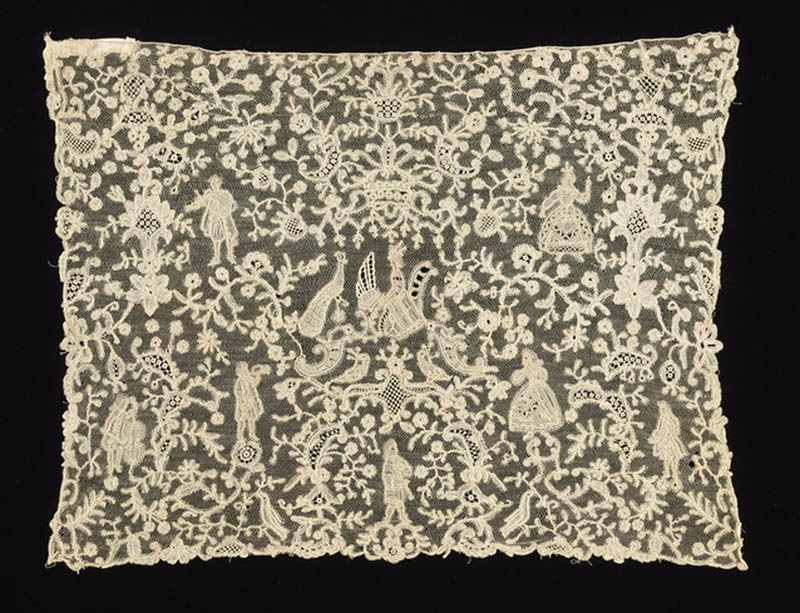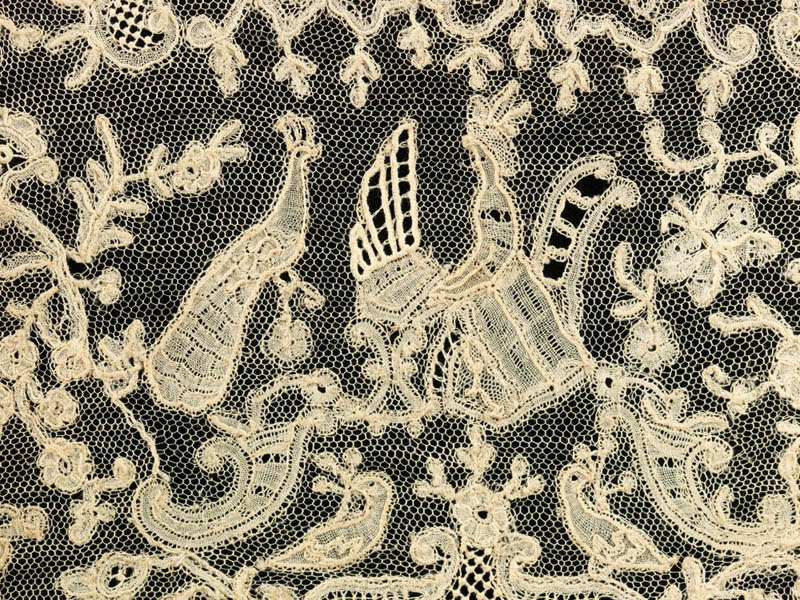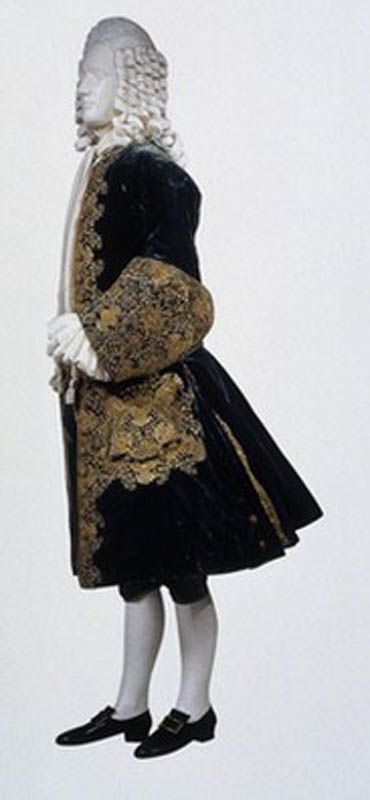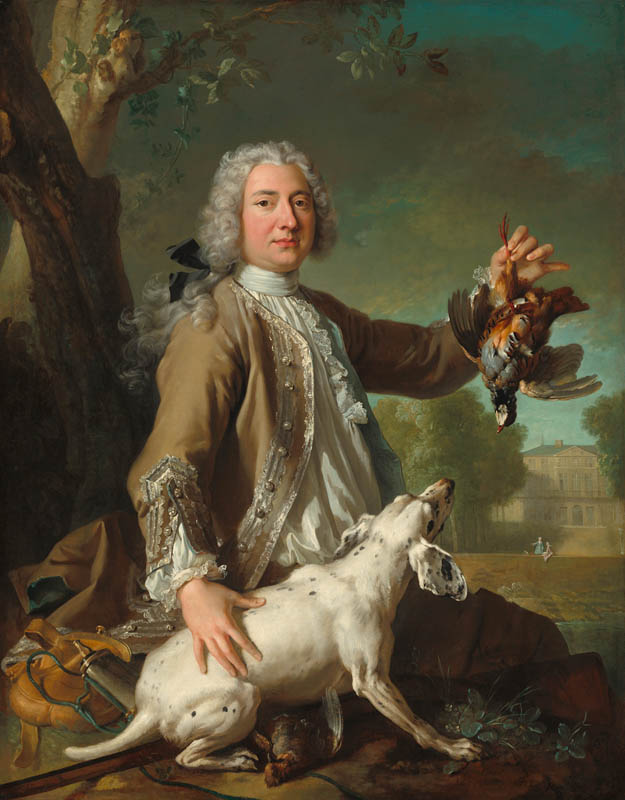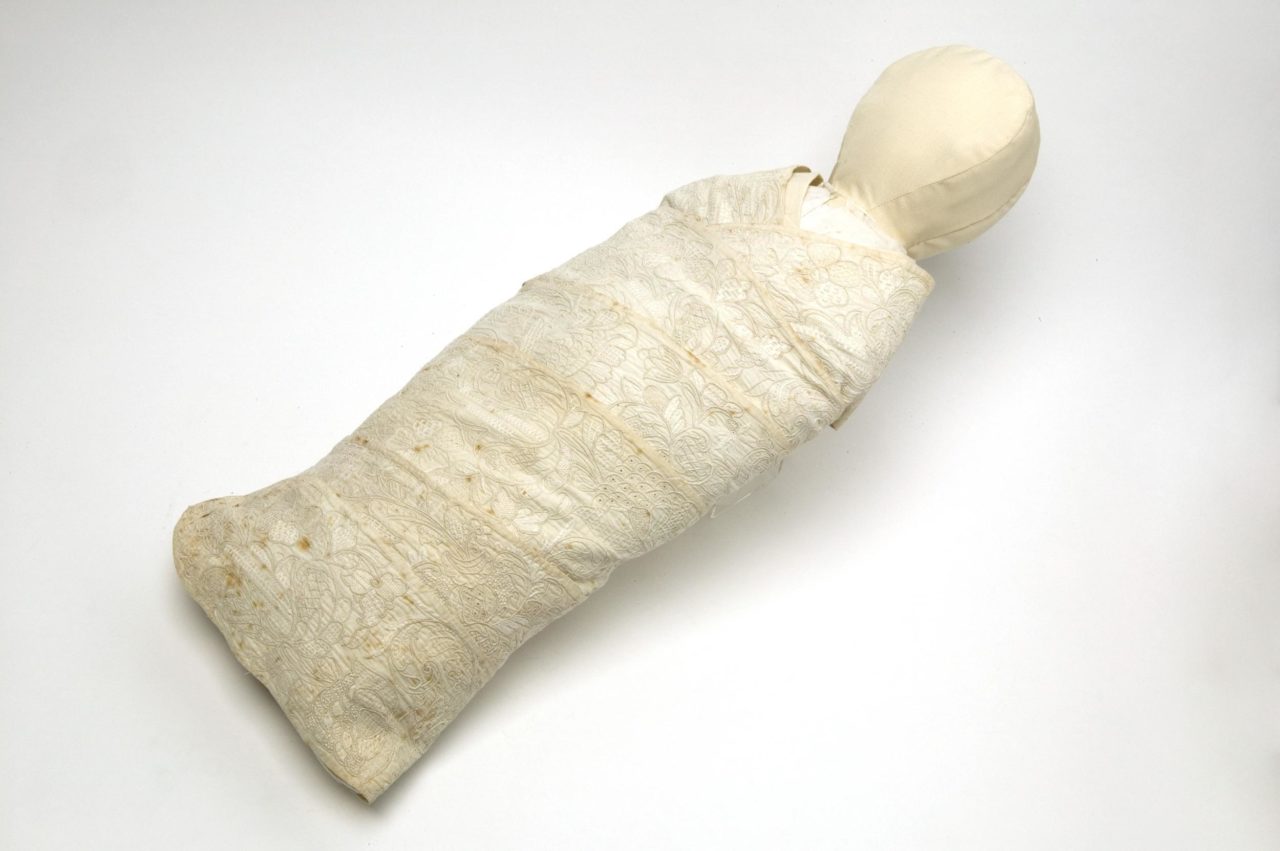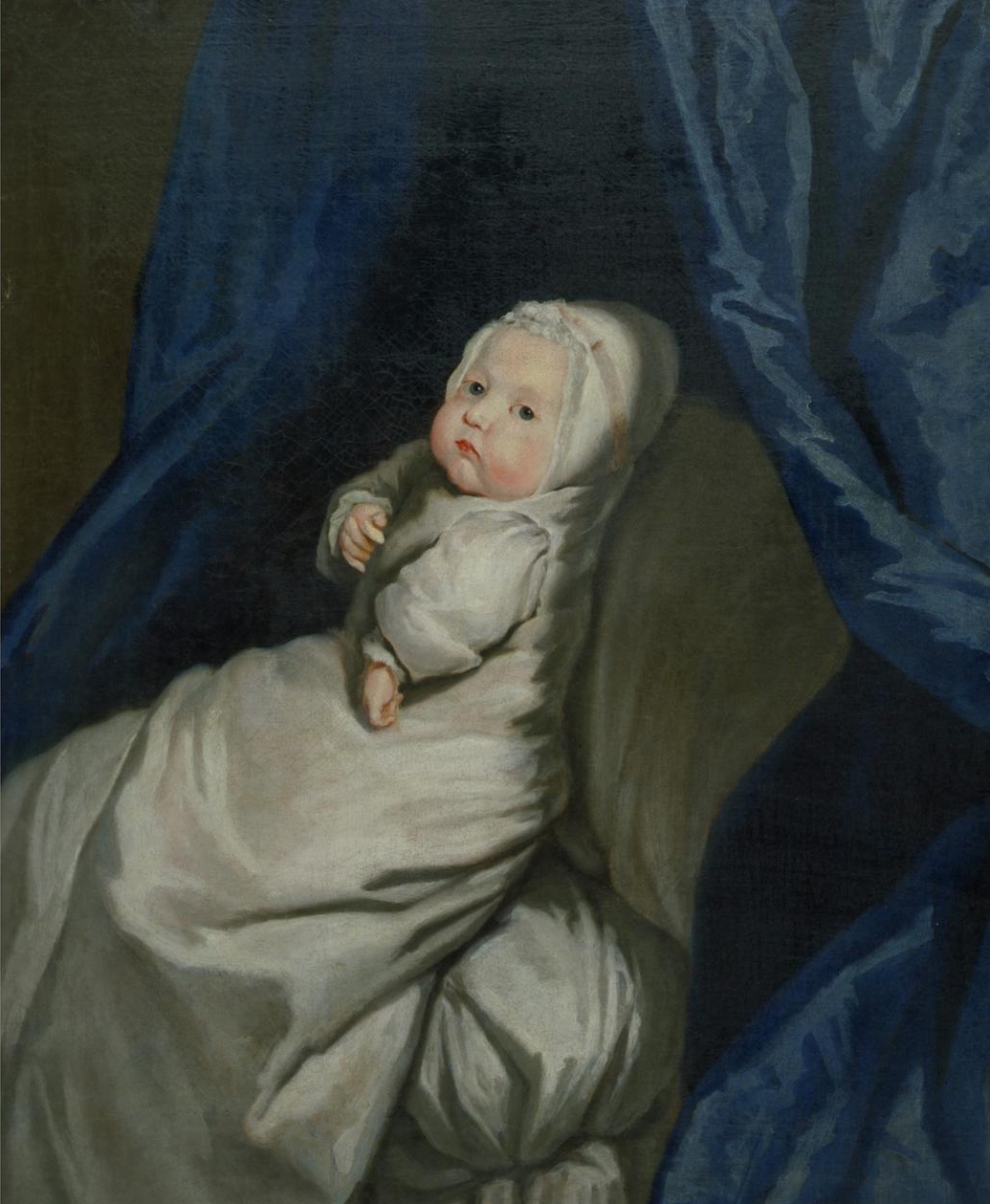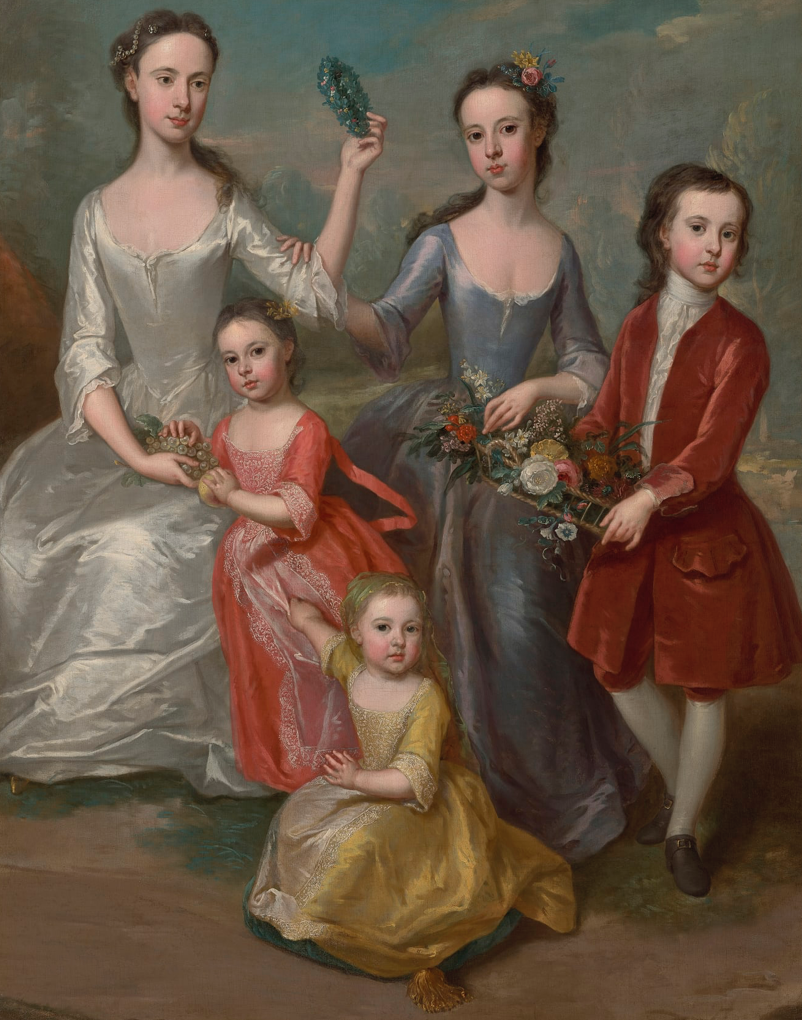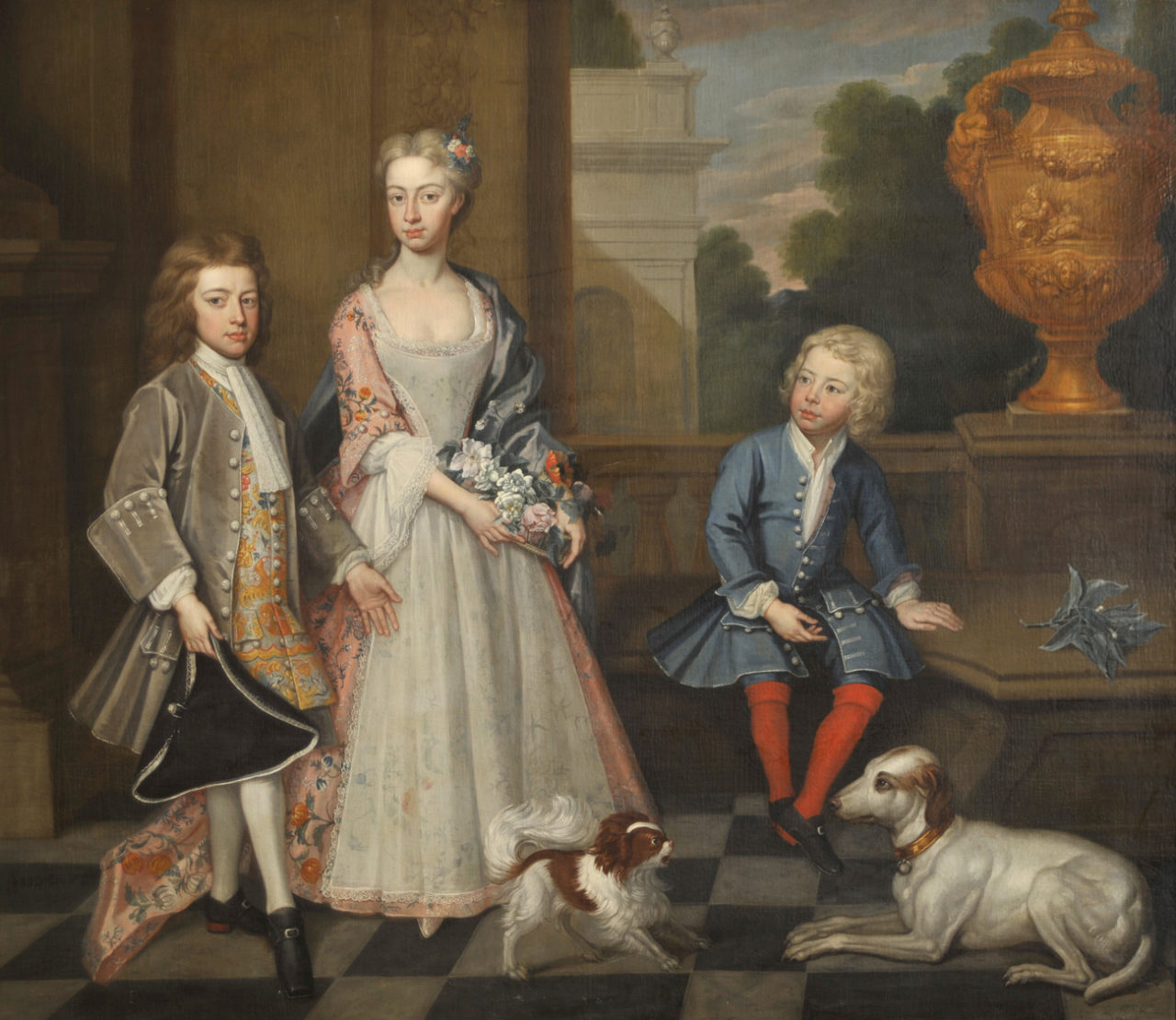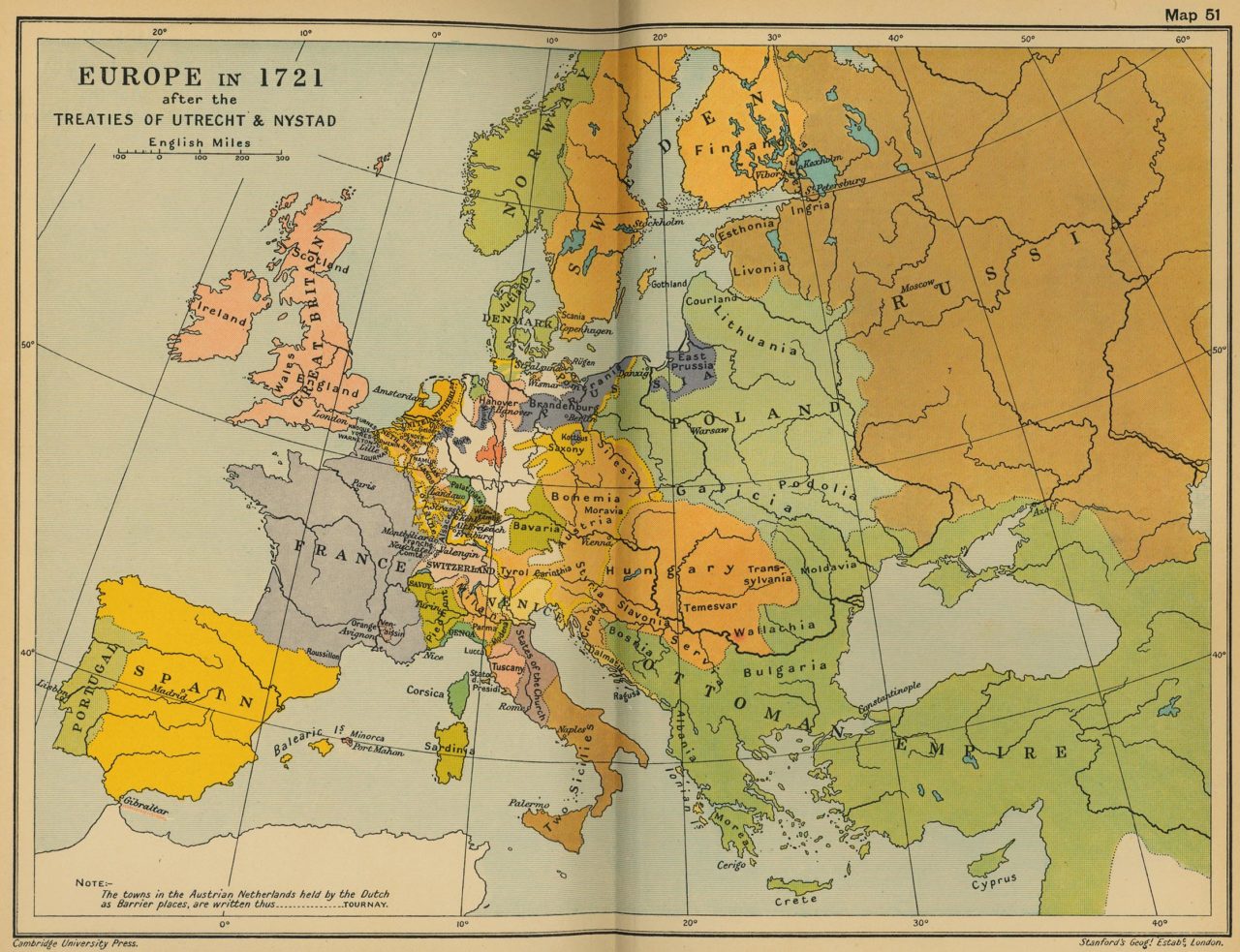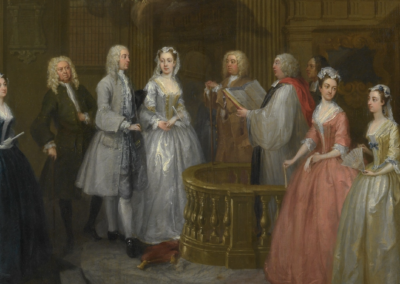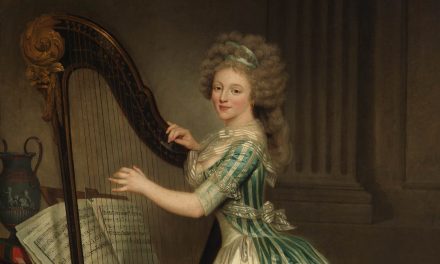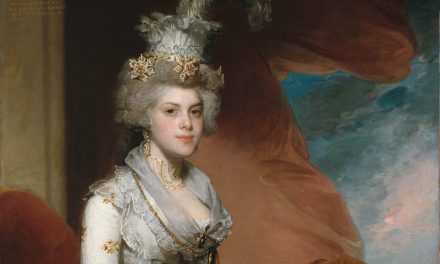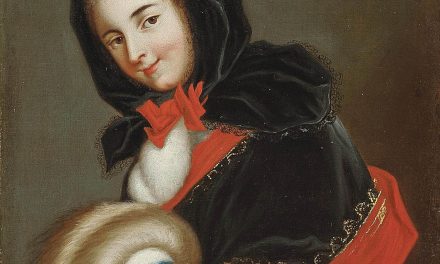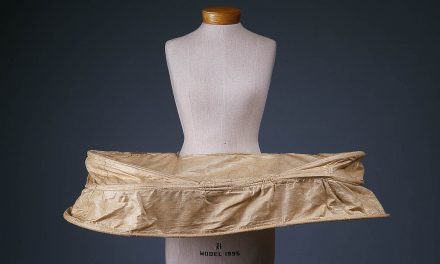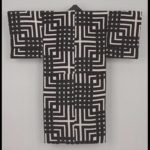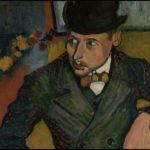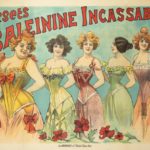OVERVIEW
The 1720s marked a distinct change in men’s and, particularly, women’s silhouettes from the two preceding decades. Although the basic forms remained the same—three-piece suits for men, and two-piece gowns for women—the shapes of these were different.
Fig. 1 - Charles-Antoine Coypel (French, 1694-1752). France's mercury fashions, 1726. Engraving. Paris: Bibliothèque Nationale de France, FRBNF41048856. Source: BnF Gallica
Fig. 2 - Jean Antoine Watteau (French, 1684-1721). The Signboard of Gersaint, 1720. Oil on canvas; 163 x 308 cm. Berlin: Charlottenburg Palace. Source: Art Resource
Womenswear
By the 1720s, the robe volante or the robe battante, known in England as a sack, that made its first tentative appearance around 1716 was the dominant everyday gown, replacing the mantua that had been worn since the 1680s. In France, the mantua went out of vogue entirely. In February 1726, the Mercure de France observed that:
“It is only young, marriageable girls who are in stays, with the mantua and petticoat of the same fabric. All the women are in corsets [less heavily boned stays], and in robes volantes, without a belt, with very full paniers” (Fig. 3/ Mercure de France, 405-406).
At the end of the decade, the publication declared that these gowns were “all the rage and one hardly sees any other dress” (quoted in Ribeiro 37). In England, however, the mantua, which had also been worn as an informal dress when first introduced in the 1670s, became fossilized into court wear that reached its peak of elaboration in the midcentury, when it was worn over wide, square hoops.
Fig. 3 - Antoine Hérisset (French, 1685-1769). Les Manteaux, 1729. Engraving; 16 x 21 cm. Paris: Bibliothèque Nationale de France, ark:/12148/btv1b525071239. Source: BnF Gallica
Fig. 4 - Maker unknown (French). Robe Volante, ca. 1720. Yellow and red changeable striped silk taffeta. Kyoto: Kyoto Costume Institute. Source: Google Arts & Culture
Fig. 5 - Maker unknown (French). Robe Volante, ca. 1730. Silk. New York: Metropolitan Museum of Art, 2010.148. Purchase, Friends of The Costume Institute Gifts, 2010. Source: The Met
Fig. 6 - Maker unknown (French). Robe Volante, ca. 1730. Silk. New York: Metropolitan Museum of Art, 2010.148. Purchase, Friends of The Costume Institute Gifts, 2010. Source: The Met
Fig. 7 - Maker unknown (British). Stomacher, ca. 1720. Silk, metal. New York: The Metropolitan Museum of Art, 2009.300.2196. Brooklyn Museum Costume Collection at The Metropolitan Museum of Art, Gift of the Brooklyn Museum, 2009; Designated Purchase Fund, 1981. Source: The Met
As the French and English names above imply, the ultra-fashionable gown of the 1720s was characterized by its billowing shape. Constructed from four widths of silk (or, cotton for the summer), the dress hung loosely from the shoulders; at the center front, the excess fabric was arranged into “flat sewn-down revers, sometimes double, extend[ing] to the waist,” known as “robings,” while across the upper back, the panels were set into wide box pleats (Ribeiro 34) (Figs. 4-6). The elbow-length sleeves were finished with fan-shaped cuffs known as en pagode that were tightly pleated inside the bend of the arm and expanded outward from the elbow (Fig. 4). Similarly, the petticoat was also constructed from joined widths of fabric that were pleated into the waist, with openings at the sides allowing access to the tied-on pockets worn over the chemise. Filling in the front opening of the gown was the stomacher, a triangular piece of woven or embroidered fabric, that could be pinned to the stays or laced with eyelet holes under the robings (Figs. 7-8). A “ladder” of ribbon bows, or échelle, graduated in size from top to bottom or faux lacing often decorated the stomacher (Fig. 8 / Ribeiro 34).
Fig. 8 - Jean François de Troy (French, 1679-1752). The Garter, 1724. Oil on canvas; 64.8 x 53.7 cm. New York: The Metropolitan Museum of Art, 2019.141.22. Bequest of Mrs. Charles Wrightsman, 2019. Source: The Met
Fig. 9 - Jean François de Troy (French, 1679-1752). The Declaration of Love, ca. 1724. Oil on canvas; 65.1 x 53.3 cm. New York: The Metropolitan Museum of Art, 2019.141.22. Bequest of Mrs. Charles Wrightsman, 2019. Source: The Met
For most of this decade, the robe volante was generally seamed at the center from just below the waist to the hem (Figs. 4-6 / Ribeiro 37). In January 1728, the Mercure de France reported that some women had started to wear these dresses open, but the style had not yet been generally adopted (Mercure de France 182).
In Jean-François de Troy’s pendant paintings depicting amorous encounters, The Garter (Fig. 8) and The Declaration of Love (Fig. 9), the young women wear robes volantes of lightweight silks, seamed at the front. The boldly striped silk gown worn by the woman tying her garter affirms the Mercure’s observation that “large striped and floral patterns could be displayed to advantage on the vast areas of material needed for the sack, especially as worn over the hooped petticoat” (Ribeiro 37-38). As de Troy’s paintings illustrate, these early iterations of the gown that would be worn until the last decades of the century were untrimmed; by 1740, applied decoration was an integral component of the more fitted robe à la française.
Although highly fashionable, the négligé aspect of the robe volante and robe battante was deemed too seductive by some. In 1721, the elderly and sartorially conservative Duchesse d’Orléans expressed her objection to these loose-fitting gowns as well as the hoop petticoat worn underneath, writing,
“I only follow the fashions from afar and there are some which I will have nothing to do with, like paniers, which I won’t wear and robes battantes which I detest. I find them indecent and will not allow them in my presence. They look as if one was just going to bed.” (quoted in Waugh/Women 115)
Towards the end of the decade, the dramatist and novelist Pierre de Marivaux, many of whose plays involve aspects of love, deception, and self-discovery, compared the robe volante to “an honest equivalent of nudity… a feigned rejection of coquetry” (quoted in Ribeiro 37).
Another informal ensemble, borrowed from the practical dress of working-class women and comprising a jacket bodice, or casaquin (Fig. 10), and petticoat, also entered the wardrobe of fashionable women during the 1720s. However, unlike the robe volante that was worn both indoors and out in urban settings, this two-piece costume was restricted to “the privacy of the home or for country pursuits,” and it was not until the last quarter of the eighteenth century that it was widely adopted for everyday stylish attire (Ribeiro 33).
For formal wear, French women continued to wear the grand habit with its heavily boned bodice, petticoat, and long train, now with the addition of the ubiquitous panier. François Stiémart’s 1725 portrait of Queen Marie Leczysnka, wife of Louis XV, in a grand habit reprises an earlier portrait of the Duchesse de Bourgogne, even to the jewels adorning the bodice (Fig. 11). The design of the silk, however, with its large-scale symmetrical composition, densely woven with gold metallic thread that sets off the coral-colored, green, and ivory details of the stylized floral and foliate motifs, is typical of the 1720s (Rothstein 40-41). At the time, the areas of diaper patterning and fillings that also characterize these silks prompted a comparison to contemporary lace. In 1729, Mrs. Delany, the gifted embroiderer and prolific correspondent, who often commented on her own or others’ clothes (particularly the more lavish), described a French silk for which she had paid the high price of L17 a yard to be made up into a dress to wear at court; the ground was “dark grass green, brocaded in a running pattern like lace of white intermixt with festoons of flowers in faint colours” (quoted in Ribeiro 41). Lace-pattern designs also appeared in monochromatic damasks (Fig. 12).
Women’s undergarments included the T-shaped, white linen chemise, a boned corset, and, most importantly, the hoop petticoat, or panier. Introduced in 1709 in England and in the following decade in France, the hoop was worn by all fashionable women and, according to the Mercure de France in March of 1729, even servant women went to market in their paniers (Mercure de France 611). Although its shape changed between the 1720s and the 1780s, when it was replaced by a crescent pad, the panier created the distinctive female silhouette associated with the eighteenth-century female silhouette (Fig. 13).
Fig. 10 - Antoine Hérisset (French, 1685-1769). Les Casaquins, after 1730. Etching. Amsterdam: Rijksmuseum, RP-P-1907-4065. Gift of J. de Jong Hanedoes, 1907. Source: Rijksmuseum
Fig. 11 - François Stiémart (French, 1680-1740). Marie Leszczynska, queen of France, 1726. Oil on canvas; 206.5 x 147 cm. Versailles: Chateau de Versailles, MV 3754. Source: Chateau de Versailles
Fig. 12 - Maker unknown (French). Robe Volante, ca. 1730. Silk. New York: Metropolitan Museum of Art, 2010.148. Purchase, Friends of The Costume Institute Gifts, 2010. Source: The Met
Fig. 13 - Antoine Hérisset (French, 1685-1769). Les Paniers, after 1729-1730. Etching. Amsterdam: Rijksmuseum, RP-P-1907-4066. Gift of J. de Jong Hanedoes, 1907. Source: Rijksmuseum
As it increased in popularity and volume, the hoop petticoat continued to draw the ire of social commentators regarding its indecency, its incommodiousness, and its tendency to blur class distinctions and promote social climbing. In a 1724 play by Marc-Antoine Legrand entitled Les paniers ou la vielle précieuse, “the precious old lady” Melissa, a petty bourgeoise, deludes herself that her aristocratic husband-to-be is not interested in her money. Preparing for her wedding, she asks, “Furthermore, when I am adorned in a beautiful fashionable panier, will I not have the air of a princess?” (quoted in Bruna 104). A lengthy treatise published in 1727, entitled Satyre sur les cerceaux, paniers, criardes, et manteaux volans des femmes et sur leurs autres ajustemens (Satire on Ladies’ Hoops, Paniers, Linen Petticoats, Flying Mantuas and Other Adjustments) takes aim at the hoop’s ability to hide physical defects (bodies that are either too fat or too thin) and pregnancies as well as the costs (to husbands) that it incurred in the amount of material needed to cover its great expanse (Bruna 105). Despite these frequent attacks, at the end of the decade, the Mercure de France declared that, although paniers were bigger than ever, caused difficulties for those who wore them, and inconvenienced and shocked others, women were not willing to give them up (Mercure de France, 611).
Under the swaying hoop petticoat, women’s ankles and feet were now tantalizingly visible. In de Troy’s The Garter, a young woman refuses the offer of a young man to help her reattach her garter while allowing him full view of her stockinged lower calf and foot, delicately shod with a backless slipper, or mule (Fig. 8). Both mules and shoes of the 1720s feature narrow pointed toes and high heels (Fig. 14). The fragile dress silks that were used to confect women’s footwear made them unsuitable for prolonged outdoor wear and matching clogs were sometimes worn indoors, or when leaving or entering a house to be helped into or from a carriage (Fig. 15).
Working-class and country women, who were regularly exposed to inclement weather and unpaved streets, wore pattens, a type of overshoe with leather latchets and a wood sole supported on a large iron ring. However, a pair in the collection of the Victoria & Albert Museum with “pointed toes to fit a fashionable woman’s shoe and a depression at the back where a small heel could sit” and velvet-covered latchets “suggests that the pattens were worn by someone of considerable wealth” (Fig. 16).
Fig. 14 - Maker unknown (English). Pair of Shoes, ca. 1720. Leather, silk. London: Victoria and Albert Museum, T.446&A-1913. Given by Messrs Harrods Ltd.. Source: V&A
Fig. 15 - Maker unknown (British). Shoe and Patten, 1720-20. Silk, silver braid, silk damask, damask weaving. London: Victoria and Albert Museum, T.600A-1913. Given by Messrs Harrods Ltd.. Source: V&A
Fig. 16 - Maker unknown (British). Pair of Pattens, 1720s-1730s. Wood, iron, leather, silk velvet. London: Victoria and Albert, T.43&A-1932. Given by Miss F. R. Shipley. Source: V&A
Fig. 17 - Jean Antoine Watteau (French, 1684-1721). The Signboard of Gersaint, 1720. Oil on canvas; 163 x 308 cm. Berlin: Charlottenburg Palace. Source: Art Resource
Fig. 18 - Jean Antoine Watteau (French, 1684-1721). The Signboard of Gersaint, 1720. Oil on canvas; 163 x 308 cm. Berlin: Charlottenburg Palace. Source: Art Resource
Fig. 19 - Maker unknown (Flemish). Cap crown and pair of lappets, 1720-40. Bobbin lace. New York: Metropolitan Museum of Art, 30.135.117a-c. Gift of Mrs. Edward S. Harkness 1930. Source: The Met
Strikingly different from women’s high coiffures and the towering fontange headdress of the opening years of the eighteenth century were the short, tightly curled hairstyles of the 1720s, with correspondingly minimal embellishment (Figs. 17, 18). In February 1726, the Mercure de France reported that these fashionable hairstyles might be left entirely unadorned, “without a ribbon or a cornette [a type of linen cap], unless it is very small with the peak scarcely visible at the top of the forehead, which gives an air of youth that is completely gallant.” It also noted that embellishments and caps “are always very small, very low, and very light [and] they are made of plain muslin, gauze, or silk lace” and it identified au courant adornments for the head including small ribbon bows forming a tuft with artificial flowers, jeweled butterflies, and “other gallant ornaments” (Figs. 9, 10, 17, 18 / Mercure de France 406).
Like the fontange, however, the new, small caps could be worn with lappets, two long bands of lace, muslin, or gauze that hung down over the shoulders or might be pinned up to the cap. During the 1720s, these were generally “straight-sided [and] square-ended” (Levey 67). On January 29, 1728, the Daily Journal reported the loss, near Covent Garden, of “a small Past-board Box, with new Lace for a Head and Ruffles, the two Lappets shap’d and scollopt, and rounded at the Ends.” The scalloped edges and rounded ends (Fig. 19) highlighted in the announcement “anticipated the lappet shape of the 1730s” (Levey 67). The Exact Dress of the Head, Drawn from the Life at Court, Opera, Theatre, & Park, & c. by Bernard Lens, published in 1726, presents fashionable women’s headwear and the many ways in which lappets could be worn (Figs. 20, 21). The numerous variations “depended mainly on the position of the cap… the exact point at which the lappets were attached and their length” (Levey 67). The Mercure de France also described the “almost infinite variety of different arrangements” that were known by particular names according to their configuration and ornaments (Fig. 22 / Mercure de France 406).
Fig. 20 - Bernard Lens (British). The Exact dress of the Head, 1725-1726. Pen and wash. London: Victoria and Albert, E.1670-1926. Source: V&A
Fig. 21 - Bernard Lens (British). The Exact dress of the Head, 1725-1726. Pen and wash. London: Victoria and Albert, E.1677-1926. Source: V&A
Fig. 22 - Artist unknown (French). Mercure de France, vol. 10, no. 5 (May 1726). Source: Hathi Trust Digital Library
Fashion Icon: MARIE SALLÉ (1707-1756), Dancer
Although women of the court and aristocracy were most often in the public eye during the eighteenth century, other women—notably actresses and dancers—were also well known and admired. Marie Sallé, a dancer who performed in both Paris and London, gained attention and praise for her grace and the expressive interpretations of her stage roles as well as for her daring attempts to reform the cumbersome traditional costumes that limited choreography for female dancers and were often historically inaccurate (Figs. 1, 2). The daughter of an itinerant fairground tumbler, Sallé began her career in 1718 at the age of 11 in an opéra comique, La Princesse [de] Carisme, at the St. Laurent fair in Paris, as part of her uncle’s troupe that also performed at Lincoln’s Inn Fields in London (Andros; McCleave 1). Over the next few years, Sallé and her brother, with whom she danced throughout her career, continued to tour in fairs and, in 1721, she made her debut at the Paris Opera in Les Fêtes Venitiennes (Andros). At that time, she also studied under Françoise Prévost, a leading ballerina at the Opera, and she continued to appeared on both sides of the Channel. In the 1740s, Sallé returned to performing at the foires and occasionally appeared before the French court in her late years (McCleave 1). Throughout her career, Sallé enjoyed friendships with men of letters, including Voltaire. A pastel portrait of Sallé by Maurice-Quentin de la Tour (Fig. 3) dating to 1741 shows her à la salonnière fashionably dressed in a pink silk robe à la française trimmed with self-fabric, a white lace cap tied with matching ribbons under her chin, and deep, double-layered engageantes.
A 1732 portrait of Sallé (Fig. 4) by Nicolas Lancret (later engraved) depicts her in an outdoor setting near a circular, colonnaded temple with a statue of Terpsichore and other ballerinas and young boys playing wind instruments. Rather than the two-piece gown-and-petticoat ensemble, Sallé wears a one-piece dress with a corseted bodice, as do the dancers behind her. The full skirt, adorned with swagged flounces and pink silk bows and supported by a pannier, follows the fashionable silhouette, yet the hem is short enough to display her delicate ankles and heeled shoes. Although Sallé’s great rival, Marie-Anne de Cupis de Camargo (1710-1770), is generally credited with being the first to shorten her skirt in order to show off her mastery of complex footwork, she was not the only leading dancer to adopt this style that allowed for great freedom of leg movement (Cooper 35). In another Lancret portrait (Fig. 5), Sallé’s foot is a focal point of the painting. The ballerina sits in a landscape wearing a salmon-colored silk open robe with its skirts pulled well back, revealing the expanse of her petticoat with a brown-and-gold swirling floral and foliate pattern. Her left arms rests on a balustrade, while her elevated and well-turned out right leg and foot are prominently visible.
One of Sallé’s triumphs was as Galatea in Pygmalion, a ballet which she choreographed and which was first presented at Covent Garden on January 14, 1734 (Andros). In April, the Mercure de France published a description of Pygmalion in the form of a letter from London, where the ballet had been highly successful with audiences, that evokes Sallé’s emotional, gestural style as the sculpture coming to life:
“the statue… gradually emerges from its insensibility; she expresses astonishment at her new existence and at all the objects that surround her. Pygmalion… holds out his hand for her to step from her position; she tests the ground, as it were, and gradually steps into the most elegant poses that a sculptor could desire. Pygmalion dances in front of her as if to teach her to dance. She repeats after him with the simplest as well as the most difficult and complicated steps.” (quoted in Goff)
Fig. 1 - Artist unknown (French). La Terpsicore Françoise, ca. 1720-1730. Dance Research: The Journal of the Society for Dance Research Vol. 17, No. 1 (Summer, 1999), pp. 22-46 (25 pages). Source: JSTOR
Fig. 2 - Louis-René Boquet (French, 1717-1814). Mlle Sallé : [maquette de costume], early 18th century. Iron gall ink; 28.1 x 235 cm. Paris: Bibliothèque nationale de France, ark:/12148/btv1b84555229. Source: BnF Gallica
Fig. 3 - Maurice Quentin de La Tour (French, 1704-1788). Portrait of Mademoiselle Sallé, 1741. Pastel on paper; 81.9 x 64.3 cm. Lisbon: Calouste Gulbenkian Museum, Inv. 24. Purchased 1928. Source: Wikimedia Commons
Fig. 4 - Nicolas Lancret (French, 1690-1743). Marie Sallé, 1732. Berlin-Brandenburg: Rheinsberg House. Source: AKG-Images
Fig. 5 - Nicolas Lancret (French, 1690-1743). Mademoiselle Marie Sallé, ca. 1735. Oil on panel; 27.9 x 33 cm. Boston: Museum of Fine Arts Boston, 65.2647. Bequest of Forsyth Wickes–The Forsyth Wickes Collection. Source: MFA Boston
Fig. 6 - Louis Michel van Loo (French, 1707-1771). Portrait de Mlle Marie Sallé, 1737. Oil on canvas; 117 x 90 cm. Nancy: Musée des Beaux-Arts, inv.D53-2-9. Source: The Réunion des Musées Nationaux
Fig. 7 - Johann Friedrich Lück (Saxon, 1728/29-1797). Dancer (one of a pair), ca. 1758. Hard-paste porcelain. New York: The Metropolitan Museum of Art, 64.101.286. Gift of Irwin Untermyer, 1964. Source: The Met
In addition to the impact made on the audience by her movements in the role of Galatea, Sallé’s provocative dress drew the attention of those who saw her performance. She discarded the usual tight bodice and full skirt for a classically inspired costume (Fig. 6). A contemporary review highlighted this dramatic—even scandalous—disregard for traditional theatrical attire:
“You can imagine, Sir, what the different stages of such an action can become when mimed and danced with the refined and delicate grace of Mlle Sallé. She has dared to appear in this entrée without pannier, skirt or bodice and with her hair down; she did not wear a single ornament on her head. Apart from her corset and petticoat she wore only a simple dress of muslin draped about her in the manner of a Greek statue.” (quoted in Andros)
Sallé’s forward-thinking attempts to reform theatrical costume in France would not be fully realized until the end of the eighteenth century.
Sarah McCleave, historian of eighteenth-century musicology and theater, has noted that Sallé’s “abilities as an expressive performer and as a creative artist accorded her the respect of her contemporaries” and that the dancer played a central role in the “early development of the ballet en action,” which emphasized “the gestural and the dramaturgical” (McCleave 1-2, 4). In his enthusiastic account of Sallé’s appearance in a 1736 revival of the opéra-ballet L’Europe galanate, the librettist Louis de Cahusac (1709-1756) attested to the dancer’s ability to move her audience: “One must praise all the more this most artistic performance, full of feeling, because it was entirely devised by the dancer. She has filled out and improved upon the framework laid down by the poet. In this she has far surpassed the talents of the ordinary performer, and shown herself to possess a rare creative talent” (McCleave 15-16).
Shortly after her death in 1756, Sallé was memorialized in a hard-paste porcelain figure based on the engraving of Lancret’s painting (Fig. 7). Standing on her toes with her arms outstretched and her head turned gracefully over her right shoulder, the diminutive dancer communicates the expressiveness and elegance associated with this widely lauded performer.
Menswear
In this decade, the most noticeable change in men’s three-piece suits was the increasing fullness of the coat skirts, with the extra side width arranged in pleats (Fig. 1 / Waugh/Men 52; Cunnington 43, 45). In March 1729, the Mercure de France reported that tailors were using large amounts of fabrics for coats and that the side pleats were “very ample, numbering five or six.” The magazine also indicated that in order to augment this volume, tailors stiffened the pleats with interlinings of horsehair, flannel, or paper (or pasteboard) to “add grace, and, as is said, to create the panier”—thereby making a direct comparison with the hoop petticoat (Mercure de France 619). The collarless coat continued to fasten down the center front with buttons, while the already wide sleeve cuffs (closed or open at the back) extended up towards the elbow (Figs. 2, 3; Figs. 8, 9 in womenswear).
Fig. 1 - Artist unknown (French). Mercure de France, vol. 10, no. 2 (February 1726). Source: Hathi Trust Digital Library
Fig. 2 - Bt Sir Godfrey Kneller (British, 1646-1723). Thomas Pelham-Holles, 1st Duke of Newcastle-under-Lyne; Henry Clinton 7th Earl of Lincoln, ca. 1721. Oil on canvas; 127 x 149 cm. London: National Portrait Gallery, NPG 3215. Given by the Art Fund, 1945. Source: NPG
Fig. 3 - Jonathan Richardson the Elder (British, 1667-1745). Francis, second Earl of Godolphin, ca. 1725. Oil on canvas; 124.5 x 99.1 cm. New Haven: Yale Center for British Art, B1981.25.530. Paul Mellon Collection. Source: Yale Center for British Art
Fig. 4 - Joseph Vivien (French, 1657-1734). Portrait of the Elector Clemens August with a teacup, ca. 1723. Oil on canvas. Brühl: Falkenlust Hunting Lodge. Source: German Digital Library
As in previous decades, the coat, waistcoat, and breeches might match, or the waistcoat might provide a contrast in color and/or pattern (Figs. 2, 3). Although most often used for women’s dresses, men wore banyans and, in some cases, suits of lace-pattern silks. In his portrait by Joseph Vivien dating to about 1725, Clemens August of Bavaria (Fig. 4) wears an extravagant blue-and-white lace-pattern silk banyan with a matching blue silk lining that closely resembles an extant morning gown in the collection of the Costume Institute (Fig. 5). Nicolas de Largillière’s 1724 portrait of Konrad Detlef (Fig. 6), later Count of Dehn, shows him in a resplendent silver-brocaded lace-pattern silk coat and waistcoat, luxurious lace-trimmed cravat (Fig. 7-8) and sleeve ruffles, and a heavily powdered full-bottomed wig.
Fig. 5 - Maker unknown. Banyan, ca. 1730. Silk. New York: Metropolitan Museum of Art, C.I.53.74.7a,b. Gift of Chester Dale, 1953. Source: The Met
Fig. 6 - Nicolas de Largillière (French, 1656-1746). Konrad Detlef Graf von Dehn, 1724. Oil on canvas; 93 x 73.4 cm. Braunschweig: Herzog Anton Ulrich Museum, GG 521. Source: Herzog Anton Ulrich Museum
Fig. 7 - Maker unknown (Flemish). Lace cravat end, 1720-40. Linen. New York: Metropolitan Museum of Art, 2009.300.3500. Brooklyn Museum Costume Collection at The Metropolitan Museum of Art, Gift of the Brooklyn Museum, 2009; Gift of Charlotte R. Stillman, 1951. Source: The Met
Fig. 8 - Maker unknown (Flemish). Lace cravat end, 1720-40. Linen. New York: Metropolitan Museum of Art, 2009.300.3500. Brooklyn Museum Costume Collection at The Metropolitan Museum of Art, Gift of the Brooklyn Museum, 2009; Gift of Charlotte R. Stillman, 1951. Source: The Met
The use of such elaborate silks for men’s suits for daywear began to decline in this decade. Aileen Ribeiro notes that by about 1720, “large floral patterns were increasingly limited to the waistcoat” and that “woven silks with small stylized floral designs were specifically woven for men’s suits”—a type of design that remained in vogue into the 1760s (Ribeiro 20). For court, however, richly woven or embroidered coats and waistcoats were still obligatory as markers of wealth and status (Fig. 9).
The principal undergarment for men remained the full-cut white linen shirt, sometimes trimmed with lace at the neck and cuffs (Figs. 4, 10). However, during this period, the cravat that had been worn since the late seventeenth century was replaced by the stock, “a made-up neckcloth fastening at the back” (Ribeiro 28). The ardent young suitors in de Troy’s paintings wear this newly fashionable neckwear (Figs. 8, 9 in womenswear) that could be “a piece of muslin or lace gathered onto a stiffened band… or it was simply the band itself fastening with a brooch or pin” (Ribeiro 28).
Men’s footwear also changed during the 1720s: the heavy, square-toed shoes of the early eighteenth century gave way to a more rounded form, and shoe buckles of various shapes including small squares or oblongs increased in size from the middle of the decade (Ribeiro 30) (Figs. 8, 9 in womenswear). At the same time, men’s stockings, formerly worn rolled up over the breeches’ knee-band, were now worn under the knee-band, creating a more streamlined shape to the leg (Figs. 8, 9 in womenswear). In May 1726, the Mercure de France declared that a large number of young men no longer wore this old-fashioned style and, instead, had adopted a buckled garter attached to the breeches to secure the stockings (Mercure de France 950).
Throughout the eighteenth century, men (and women) who could afford to had their clothes custom made. While second-hand markets had long flourished in Europe and remained an important source for middle- and lower-class consumers, ready-made garments—limited in availability—were nonetheless another avenue for the acquisition of dress, particularly for men. In March 1723, a purveyor of ready-made suits, located near Covent Garden, notified potential clients of the range of materials and prices—corresponding to two sizes: “good Drugget, Sagathie and Duroy Suits, made well and fashionable, for the first size Man at 3L 10s a Suit, and the larger size at 4L and Camlet Suits for 4L and 4L 10S a Suit” (Post Man, March 5, 1723 in Extracts from Notices, n. p.). Dressing gowns that required little or no fitting were also available ready-made. In December 1726, the proprietor(s) of “the Gown Warehouse, In Bakers Coffee-House, in Exchange-Alley” listed their:
“fresh stock of Men’s Gowns; where all Merchants or Gentlemen may be furnish’t with any Quantity, and Gowns fit for any Country; with the most complete Sort of Banjan Gowns, made after the newest Fashion, of rich double Ground Brocades, Paduasoys, Venetian, Damasks, strip’d and flower’d Lustrings, Rosatte’s, Turkey Mantua’s, Thread Sattins, Silk Plots, Scotch Plods, strip’d and flower’d Callimanco’s.” (Daily Journal, December 27, 1726 in Extracts from Notices, n.p.)
Fig. 9 - Maker unknown (French). Man's Formal Coat, ca. 1720-1730. Blue velvet embroidered in gold. Source: Fabbri, Patrizia. L'abito per il corpo: il corpo per l'abito: Islam e Occidente a confronto. Florence: Arteficio, 1998.
Fig. 10 - Jean-Baptiste Oudry (French, 1686-1755). Henri Camille, Chevalier de Beringhen, 1722. Oil on canvas; 147 x 114 cm. Washington D.C.: National Gallery of Art, 1994.14.1. Eugene L. and Marie-Louise Garbáty Fund, Patrons' Permanent Fund, and Chester Dale Fund. Source: NGA
In addition to the wide range of silk and wool fabrics, the advertisement also indicated that “the Price is fix’d on each Gown.” The practice of pricing individual garments did not become widespread until the establishment of large department stores in the second half of the nineteenth century.
Similar to women’s closely styled coiffures in this decade, men’s wigs were also curled around the head with the hair at the back tied with a black silk ribbon or enclosed in a bag (Fig. 10), known in French as a bourse or crapaud (Fig. 9 in womenswear; Ribeiro 29). This latter style might also feature “a black silk ribbon coming from the bag to tie at the front in a bow,” called a “solitaire” (Figs. 8, 9 in womenswear / Ribeiro 29). In May 1726, the Mercure de France noted that the most fashionable wigs were “tied” and many of these were worn with a variety of bags; that the curls resembled sheep’s fleece; and that young men who wore their own hair generally wore a queue rather than a bagwig (Mercure de France 949). Although the bag-wig was especially popular, there were many other styles worn at the time, depending on the wearer and the occasion. Joseph Pickeaver, a “Peruke-maker,” advertised his extensive offerings in the Dublin Gazette on February 23, 1725, that included “Full Bottoms, Tyes, Full-Bobs, Ministers-Bobs, Naturalls, Half-Naturalls, Grecian Flyes, Curley-Roys, Airy-Lavants, and Bagg-Wiggs.” Pickeaver also assured prospective customers that he was “likewise furnish’d with all sorts of Hair from the only noted Hair Merchants in England, and Ireland” and that his clientele “may be furnish’d as cheap as in London” (Extracts from Notices n. p.). While human hair was considered the best and was the most expensive, other options—such as horsehair—were also available (Ribeiro 29). When it became fashionable for women to cut their hair during the 1720s, this provided another source for wigmakers in addition to hair “from girls entering convents” (Ribeiro 29).
Powdering the wig (or natural hair) was both fashionable and de rigueur for formal occasions (Figs. 8, 9, 17, 18 in womenswear; Figs. 2, 3, 6, 10). A gentleman donned a powdering gown (generally of white linen) and sometimes sat in a designated chamber while his valet applied the powder of “finely ground starch or wheat flour (sometimes perfumed)” with a bellows-like instrument (Ribeiro 29). The even spread of powder was critical in order to achieve a correct appearance. On March 19, 1722, Markham’s Toyshop in Fleet Street placed an advertisement in the Daily Post announcing the recent arrival of:
“the new invented MACHINE for powdering of Perriwigs, dispersing the Powder all over alike in the most agreeable manner, throwing out only the finest and best of the Powder, which otherwise lies in Lumps, to the great decay of the Curl, and proper for Travelling Carriage.” (Extracts from Notices n.p.)
CHILDREN’S WEAR
(BY SUMMER LEE)
However, that was not reflected in childrenswear of the first half of the century. In the 1720s, traditions for childrenswear were not unlike those at the start of the century.
Infants were swaddled, as was the long-held European tradition (Tortora and Marcketti). Swaddling was the practice of tightly binding an infants’ limbs, so as to immobilize them (Callahan). The Victoria and Albert Museum possesses a finely embroidered swaddling band dated circa 1700-1750 (Fig. 1). Its elaborate floral embroidery indicates that this was a fashionable “outer swaddling band” (Victoria and Albert Museum).
In the early eighteenth century, babies typically outgrew the swaddling phase between two and four months (Callahan). They were then dressed in “slips” or “long clothes” (Callahan). These were ensembles with a fitted bodice and a very long, full skirt (Fig. 2) (Nunn 99). Babies also wore tight-fitting caps on their heads.
Once a child was becoming mobile, they transitioned into “short clothes” (Callahan). These ensembles allowed for greater mobility because skirts were cut at the ankle (Callahan). Bodices opened at the back and were boned or otherwise stiffened (Callahan). At this phase, toddlers typically had “leading strings” attached to the back of their bodice (Magidson). Leading strings were streamers of fabric used to protect young children from falling or wandering off (“Childhood”).
Fig. 1 - Designer unknown (French). Swaddling band, 1700-1750. Hand embroidered linen; 340.5 cm x 12.5 cm. London: Victoria and Albert Museum, B.13-2001. Source: Victoria and Albert Museum
Fig. 2 - Mary Beale (English, 1633-1699). Portrait of a Baby, 1690-1730. Oil on canvas; 77.5 cm x 65 cm. London: Victoria and Albert Museum, B.447-1994. Source: Victoria and Albert Museum
A whimsical group portrait by William Aikman circa 1720 (Fig. 3) depicts five young siblings. The two youngest children wear short clothes accessorized with white lace aprons. They would have both worn leading strings, which are visible on the back of the second-youngest child. It should be noted that while they are assumed to be girls, their ensembles would have also been appropriate for very young boys. The two older girls do not wear those clear symbols of childhood. However, their bodices open and close at the back rather than the front. The young boy wears a red menswear ensemble very similar to styles worn earlier in the century.
A 1726 group portrait by Joseph André Cellony (Fig. 4) depicts Humphry, Elizabeth and Charles Ambler as children. The fashionable ensembles worn by Humphry and Elizabeth, the two standing children, act as a visual display of wealth. They appear to wear very expensive polychrome silk brocades. Elizabeth’s ensemble includes features of leading womenswear styles, including gathered sleeves with wide cuffs and a train. However, her sheer white apron unmistakably marks her as a child. Both of Elizabeth’s brothers, who appear to be younger than her, wear menswear. Charles, seated, wears a blue suit and fashionable red stockings worn over the hem of his breeches. Humphry’s ensemble appears to be more extravagant, in large part due to the sumptuous fabric of his waistcoat. In his hand he holds a fashionable tricorne hat.
Fig. 3 - William Aikman (Scottish, 1682-1731). A Group Portrait of Four Girls and a Boy in a Landscape, ca. 1720. Oil on canvas; 173 cm x 146.6 cm (68 1/8" x 57 1/8" in). London: Philip Mould & Company. Source: Philip Mould & Company
Fig. 4 - Joseph André Cellony (French, 1686-1746). Charles Ambler with his elder brother Humphry and sister Elizabeth, 1726. Oil on canvas; 175.5 cm x 201 cm. Private Collection. Source: Wikimedia Commons
References:
- Andros, Dick. “Marie Salle, (1707-1756).” Andros on Ballet, n.d. http://michaelminn.net/andros/biographies/salle_marie/.
- Bruna, Denis. “Early 18th Century Paniers in Contemporary Sources.” In Structuring Fashion: Foundation Garments through History, edited by Frank Matthias Kammel and Johannes Pietsch, 101-107. Munich: Bayerisches Nationalmuseum; Munich: Hirmer, 2019. http://www.worldcat.org/oclc/1129699413.
- Buck, Anne. Dress in Eighteenth-Century England. London: B. T. Batsford, 1979. https://catalog.hathitrust.org/Record/100116895.
- Callahan, Colleen R. “Children’s Clothing.” In The Berg Companion to Fashion, edited by Valerie Steele. Oxford: Bloomsbury Academic, 2010. Accessed August 08, 2020. http://dx.doi.org/10.5040/9781474264716.0003223.
- “Childhood.” In European Renaissance and Reformation, 1350-1600, edited by Norman J. Wilson, 319-321. Vol. 1 of World Eras. Detroit, MI: Gale, 2001. Gale eBooks (accessed August 7, 2020). https://libproxy.fitsuny.edu:2653/apps/doc/CX3034600137/GVRL?u=fitsuny&sid=GVRL&xid=480f4328.
- Chrisman, Kimberly. “Unhoop the Fair Sex: The Campaign Against the Hoop Petticoat in Eighteenth-Century England.” Eighteenth-Century Studies, Vol. 30, No 1 (Fall 1996): 5-23 http://www.jstor.com/stable/30053852.
- Ginsburg, Madeleine. “Ladies Court Dress: Economy and Magnificence.” In The V & A Album, 5, 1986 (142-154). http://www.worldcat.org/oclc/1125308835.
- “Introduction to 18th-Century Fashion.” Victoria and Albert Museum, January 25, 2011. http://www.vam.ac.uk/content/articles/i/introduction-to-18th-century-fashion/.
- Levey, Santina. Lace: A History. London: Victoria & Albert Museum; Leeds: W.S. Maney 1983. http://www.worldcat.org/oclc/847457626.
- Magidson, Phyllis. “Fashion.” In Encyclopedia of Children and Childhood: In History and Society, edited by Paula S. Fass, 344-348. Vol. 2. New York, NY: Macmillan Reference USA, 2004. Gale eBooks (accessed August 7, 2020). https://libproxy.fitsuny.edu:2653/apps/doc/CX3402800166/GVRL?u=fitsuny&sid=GVRL&xid=0084684d.
- McCleave, Sarah. “Marie Sallé and the Development of the Ballet en action.” Journal of the Society for Musicology in Ireland, 3 (2007-8): 1-23. http://www.worldcat.org/oclc/8280044447.
- Mercure de France 10, no. 2 (February 1726): 404. https://babel.hathitrust.org/cgi/pt?id=coo.31924092970288&view=1up&seq=115&skin=2021.
- Mercure de France 10, no. 5 (May 1726): 946–59. https://babel.hathitrust.org/cgi/pt?id=coo.31924092970288&view=1up&seq=255&skin=2021.
- Mercure de France 14, no. 1 (January 1728): 182. https://babel.hathitrust.org/cgi/pt?id=coo.31924092970320&view=1up&seq=56&skin=2021.
- Mercure de France 16, no. 3 (March 1729): 611, 619. https://babel.hathitrust.org/cgi/pt?id=coo.31924092970346&view=1up&seq=171&skin=2021.
- Metropolitan Museum of Art. “The Declaration of Love,” n.d. https://www.metmuseum.org/art/collection/search/438127.
- Metropolitan Museum of Art. “The Garter,” n.d. https://www.metmuseum.org/art/collection/search/438126.
- Nunn, Joan. Fashion in Costume 1200-2000. Bridgewater, NJ: Distributed by Paw Prints/Baker & Taylor, 2008. http://www.worldcat.org/oclc/232125801
- Pratt, Lucy, and Linda Woolley. Shoes. London: V & A Publications, 1999. http://www.worldcat.org/oclc/757471429.
- Reinier, Jacqueline S. “Breeching.” In Encyclopedia of Children and Childhood: In History and Society, edited by Paula S. Fass, 118. Vol. 1. New York, NY: Macmillan Reference USA, 2004. Gale eBooks (accessed August 7, 2020). https://libproxy.fitsuny.edu:2653/apps/doc/CX3402800074/GVRL?u=fitsuny&sid=GVRL&xid=360a7a45.
- Ribeiro, Aileen. Dress in Eighteenth Century Europe. New Haven and London: Yale University Press, 2002. http://www.worldcat.org/oclc/912425456.
- Rothstein, Natalie. Silk Designs of the Eighteenth Century in the Collection of the Victoria and Albert Museum, London. Boston: Little, Brown, 1990. http://www.worldcat.org/oclc/246549873.
- Tortora, Phyllis G., and Sara B. Marcketti. “The Eighteenth Century 1700–1790.” In Survey of Historic Costume, 266–297. New York: Fairchild Books, 2015. Accessed August 07, 2020. http://dx.doi.org/10.5040/9781501304194.ch-010.
- Victoria and Albert Museum. “Swaddling Band.” V&A Collections. Accessed August 08, 2020. http://collections.vam.ac.uk/item/O62960/swaddling-band/.
- Waugh, Norah. The Cut of Men’s Clothes, 1600-1900. New York: Theatre Arts Books, 1964. http://www.worldcat.org/oclc/927414537.
- Waugh, Norah. The Cut of Women’s Clothes, 1600-1930. New York: Theatre Arts Books, 1968. http://www.worldcat.org/oclc/1074444804.
Historical Context
Wikipedia: 1720-1729
Rulers:
- Britain
- King George I (1714-1727)
- King George II (1727-1760)
- France
- King Louis XV (1715-1774)
- Spain
- King Philip V (1700-1724)
- King Louis I (1724)
- King Philip V (1724-1746)
Europe in 1721. Source: Emerson Kent
Events:
- 1721 – Smallpox vaccine developed
- 1724 – R. Holden of Dundee, Scotland, began bleaching linen with a compound made from kelp
- 1728 – Silk designer Anna Maria Garthwaite starts work in London
Primary/Period Sources
Resources for Fashion History Research
To discover primary/period sources, explore the categories below.
Have a primary source to suggest? Or a newly digitized periodical/book to announce? Contact us!
Fashion Plate Collections (Digitized)
- Costume Institute Fashion Plate collection
- Casey Fashion Plates (LA Public Library) - search for the year that interests you
- New York Public Library
Etiquette Books (Digitized)
Secondary Sources
Also see the 18th-century overview page for more research sources… or browse our Zotero library.

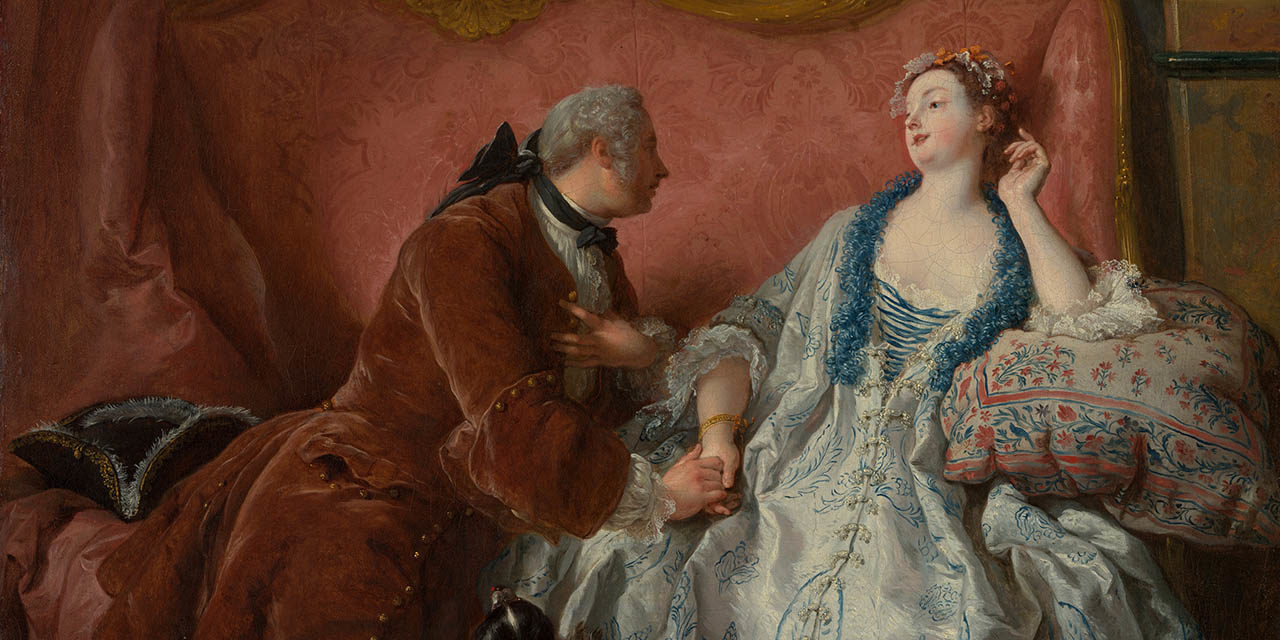
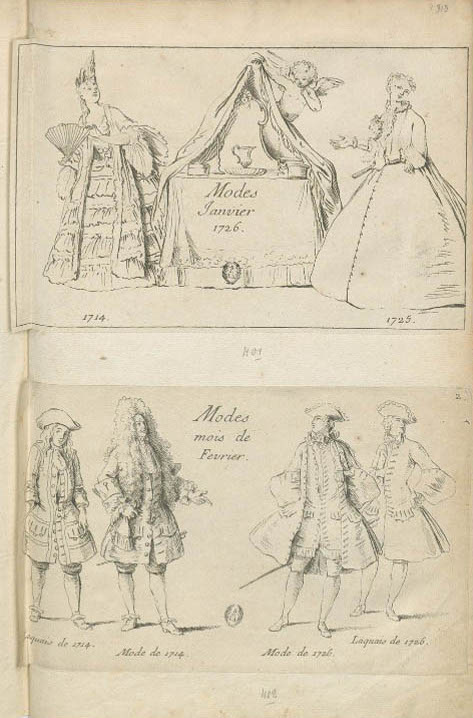







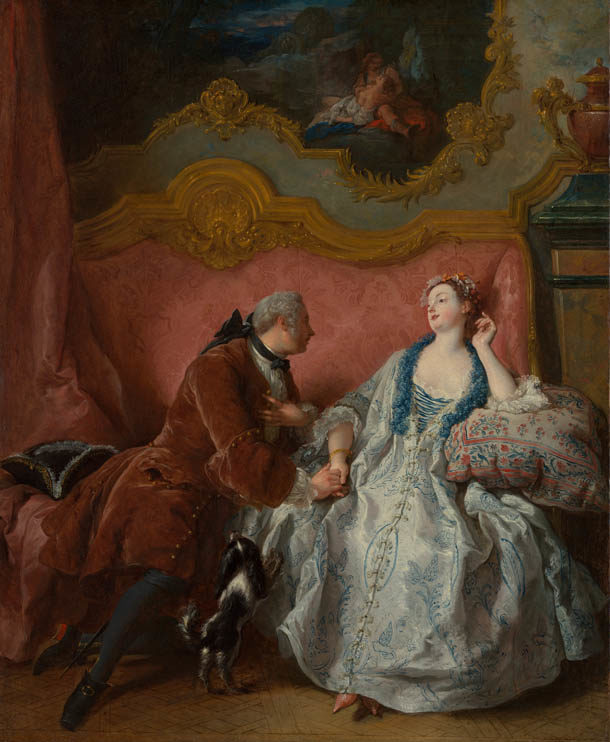










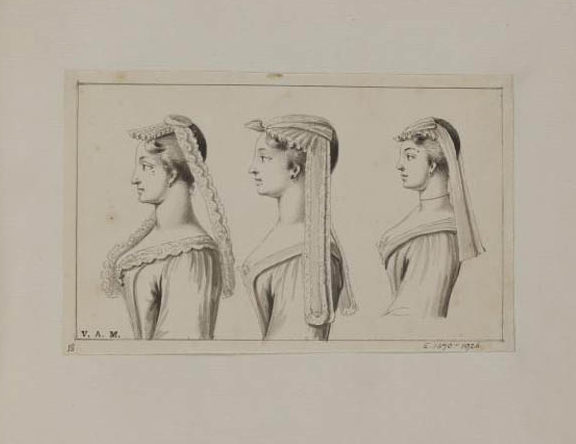
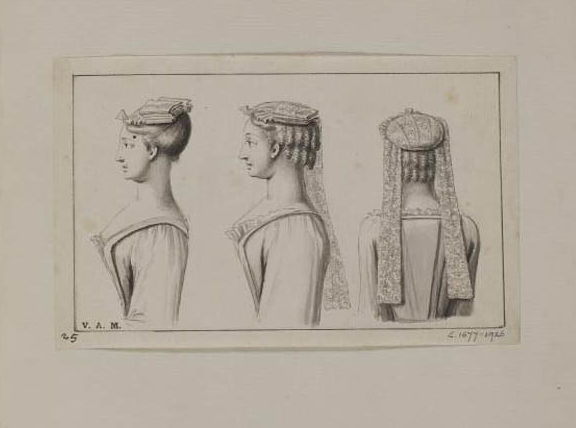

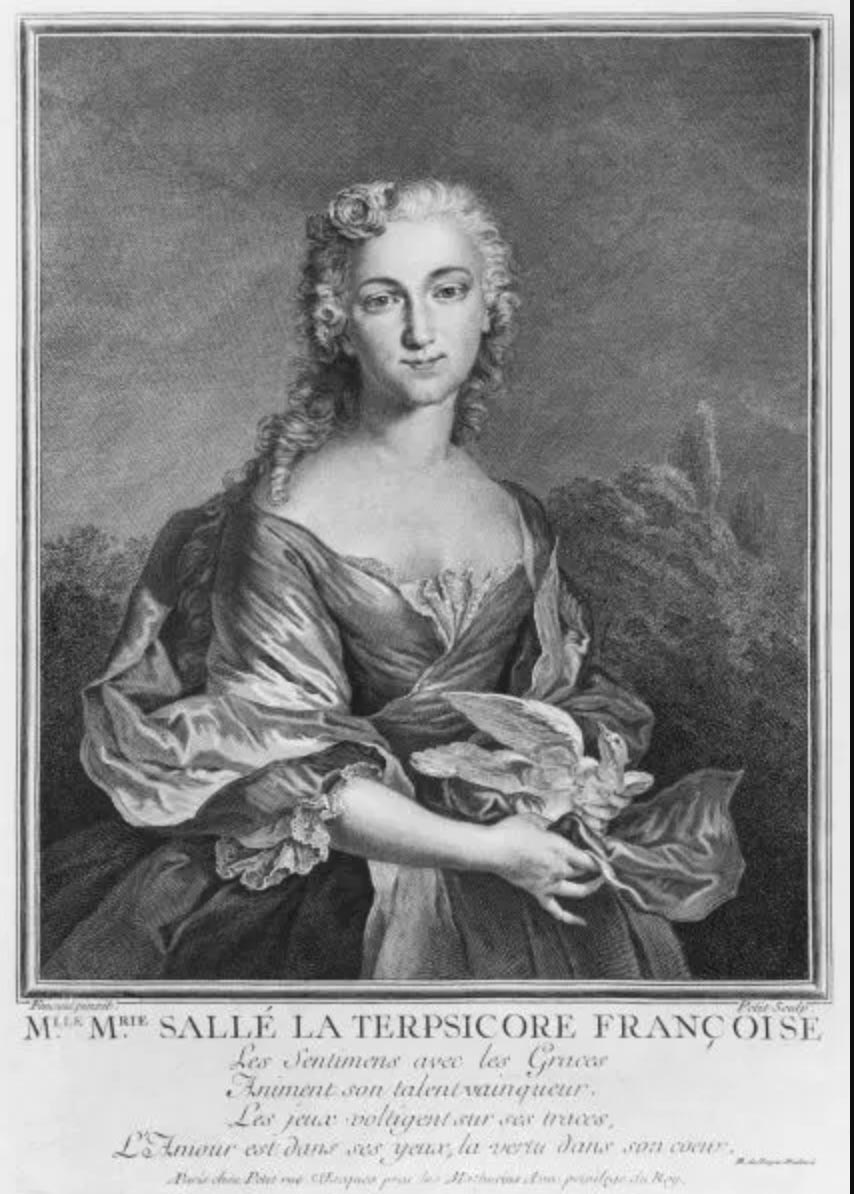
![Mlle Sallé : [maquette de costume] Mlle Sallé : [maquette de costume]](https://fashionhistory.fitnyc.edu/wp-content/uploads/2021/05/fig34.jpg)
